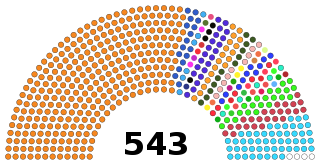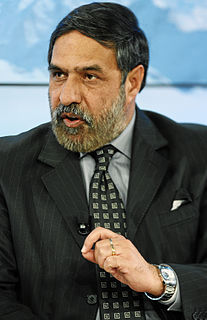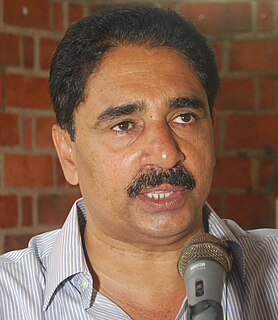Related Research Articles

The Rajya Sabha or Council of States is the upper house of the bicameral Parliament of India. It currently has a maximum membership of 245, of which 233 are elected by the legislatures of the states and union territories using single transferable votes through Open Ballot while the President can appoint 12 members for their contributions to art, literature, science, and social services. The potential seating capacity of the Rajya Sabha is 250, according to article 80 of the Indian Constitution. Members sit for staggered terms lasting six years, with elections every year but almost a third of the 233 designates up for election every two years, specifically in even-numbered years. The Rajya Sabha meets in continuous sessions, and unlike the Lok Sabha, being the lower house of the Parliament, the Rajya Sabha, which is the upper house of Parliament, is not subjected to dissolution. However, the Rajya Sabha, like the Lok Sabha can be prorogued by the President.

The Lok Sabha, or House of the People, is the lower house of India's bicameral Parliament, with the upper house being the Rajya Sabha. Members of the Lok Sabha are elected by an adult universal suffrage and a first-past-the-post system to represent their respective constituencies, and they hold their seats for five years or until the body is dissolved by the President on the advice of the council of ministers. The house meets in the Lok Sabha Chambers of the Sansad Bhavan, New Delhi.

The Parliament of India is the supreme legislative body of the Republic of India. It is a bicameral legislature composed of the President of India and the two houses: the Rajya Sabha and the Lok Sabha. The President in his role as head of legislature has full powers to summon and prorogue either house of Parliament or to dissolve Lok Sabha. The president can exercise these powers only upon the advice of the Prime Minister and his Union Council of Ministers.
The 14th Lok Sabha was convened after the 2004 Indian general election held in four phases during 20 April – 10 May 2004, which led to the formation of first Manmohan Singh ministry (2004–2009). Indian National Congress-led United Progressive Alliance won 62 more seats than previous 13th Lok Sabha. The Lok Sabha is the lower house in the Parliament of India. 8 sitting members from Rajya Sabha, the Upper House of Indian Parliament, were elected to 14th Lok Sabha after the 2004 Indian general election.
India is a country, divided into states and union territories, with a parliamentary system governed under the Constitution of India, which defines the power distribution among the federal government and the states.

Anand Sharma is an Indian politician and former Union Cabinet Minister in charge of Commerce and Industry and Textiles in the Government of India. Since June 2014, Sharma is the Deputy Leader of opposition in Rajya Sabha, the upper house of the Indian Parliament.

N. K. Premachandran is an Indian politician. He is presently the Member of Parliament from Kollam Lok Sabha constituency. He was the former minister for Water Resources in the government of Kerala and was responsible for irrigation, ground water development, water supply and sanitation. He was a Member of the both the houses of the Parliament of India. He is known for his public speeches. Premachandran has written a book "Oh Iraq" based on his travel experience to Iraq. He was instrumental in taking up the issue of the safety of Mullaperiyar Dam.
Chander Kishan Daphtary was an Indian lawyer and was the first Solicitor General of India from 1950 to 1963. He was the Attorney General for India from 1963 to 1968. He was the President of the Bar Association of India. He was nominated to the Rajya Sabha the Upper House of Indian Parliament from 1972 to 1978. He was awarded the Padma Vibhushan in 1967
Rajni Patil is an Indian politician representing the Indian National Congress. She is currently the All India Congress Committee In-charge for Jammu & Kashmir. She was a Member of Parliament, representing Maharashtra in the Rajya Sabha .She was elected unopposed in a Rajya Sabha bye election in 2013.. She was awarded the Best debut Parliamentarian award for her performance in the Rajya Sabha. She was elected to the Lok Sabha(the lower house of the Indian Parliament) from Beed in 1996. In 2005, she was elected as the Chairperson of the Central Social Welfare Board. She represented India at the 49th session of the UN Commission on the status of women at the UN headquarters in New York. She was a student political leader in college in the National Students Union of India(NSUI). She started her career in electoral politics by getting elected to the Zilla Parishad in 1992.

A Member of Parliament in Lok Sabha is the representative of the Indian people in the Lok Sabha; the lower house of the Parliament of India. Members of parliament of Lok Sabha are chosen by direct elections on the basis of the adult suffrage. Parliament of India is bicameral with two houses; Rajya Sabha and the Lok Sabha. The maximum permitted strength of members of parliament in the Lok Sabha is 550. This includes maximum 530 members to represent the constituencies and states and up to 20 members to represent the union territories. Between 1952 and 2020, two seats were reserved for members of the Anglo-Indian community. The current elected strength of the Lok Sabha is 543. The party—or coalition of parties—having a majority in the Lok Sabha chooses the Prime Minister of India.

A Member of Parliament in the Rajya Sabha is the representative of the Indian states to the one of the two houses of the Parliament of India. Rajya Sabha MPs are elected by the electoral college of the elected members of the State Assembly with a system of proportional representation by a single transferable vote. Parliament of India is bicameral with two houses; Rajya Sabha and the Lok Sabha. The total number of members of Rajya Sabha are lesser than the Members of Parliament in the Lok Sabha and have more restricted power than the lower house. Unlike membership to the Lok Sabha, membership to the Rajya Sabha is permanent body and cannot be dissolved at any time. However every second year, one third of the members are retired and vacancy are filled up by fresh elections and Presidential nomination at the beginning of every third year.

Member of parliament in India refers to persons who serve in the parliament of that country. These include:
Vanga Geetha is an Indian politician. She was elected to the Lok Sabha, lower house of the Parliament of India from Kakinada, Andhra Pradesh as a member of the YSR Congress Party. She was earlier a Member of Parliament, representing Andhra Pradesh in the Rajya Sabha the upper house of India's Parliament representing the Telugu Desam Party.
Babubhai Maneklal Chinai is an Indian politician. He was a Member of Parliament representing Maharashtra in the Rajya Sabha the upper house of India's Parliament. He was awarded India's third highest civilian honour the Padma Bhushan in 1966.
Indra Vidyavachaspati was an Indian politician. He was a Member of Parliament, representing Uttar Pradesh in the Rajya Sabha the upper house of India's Parliament as a member of the Indian National Congress

2020 Rajya Sabha elections is the set of indirect elections by the members of State legislatures of India, to elect new members to fill vacancies in the Rajya Sabha – the upper house of the Parliament of India. The elections are held annually and throughout the year on an ad hoc basis. The elections in 2020 are for a total of 73 seats of which 55 of them were to be elected by March 26. The remaining were postponed due to the COVID-19 pandemic. The Election Commission of India later announced all the elections for the remaining 24 Rajya Sabha seats were to be held on 19 June 2020.
References
- ↑ "RAJYA SABHA MEMBERS BIOGRAPHICAL SKETCHES 1952 - 2003" (PDF). Rajya Sabha . Retrieved 17 March 2019.
- ↑ Economic and Political Weekly. Sameeksha Trust. 1984. p. 534. Retrieved 17 March 2019.
- ↑ India Today. Thomson Living Media India Limited. 1991. p. 64. Retrieved 17 March 2019.